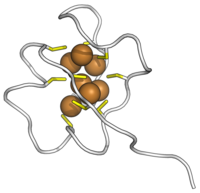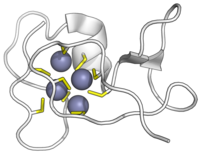|
Metal-binding proteinExample metal binding proteins Saccharomyces cerevisiae MT metallothionein bound to copper ions. Cysteines in yellow, copper in brown. (PDB: 1AQS) Cyanobacterial SmtA metallothionein bound to zinc ions. Cysteines in yellow, zinc in purple. (PDB: 1JJD) Metal-binding proteins are proteins or protein domains that chelate a metal ion.[1] Binding of metal ions via chelation is usually achieved via histidines or cysteines. In some cases this is a necessary part of their folding and maintenance of a tertiary structure. Alternatively, a metal-binding protein may maintain its structure without the metal (apo form) and bind it as a ligand (e.g. as part of metal homeostasis). In other cases a coordinated metal cofactor is used in the active site of an enzyme to assist catalysis. Histidine-rich metal-binding proteinsPoly-histidine tags (of six or more consecutive His residues) are utilized for protein purification by binding to columns with nickel or cobalt, with micromolar affinity.[2] Natural poly-histidine peptides, found in the venom of the viper Atheris squamigera have been shown to bind Zn(2+), Ni(2+) and Cu(2+) and affect the function of venom metalloproteases.[3] Furthermore, histidine-rich low-complexity regions are found in metal-binding and especially nickel-cobalt binding proteins.[4] These histidine-rich low complexity regions have an average length of 36 residues, of which 53% histidine, 23% aspartate, 9% glutamate.[4] Intriguingly, structured domains with metal binding properties also have very similar frequencies of these amino acids that are involved in the coordination of the metal.[5] Accordingly, it has been hypothesized that these metal-binding structured domains could have originated and evolved/optimized from metal-binding low-complexity protein regions of similar amino acid content.[4] References
|

